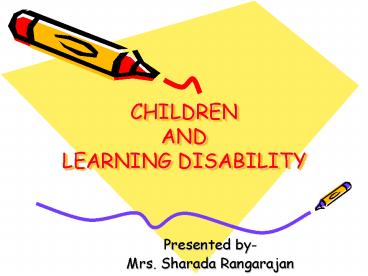CHILDREN AND LEARNING DISABILITY - PowerPoint PPT Presentation
1 / 23
Title:
CHILDREN AND LEARNING DISABILITY
Description:
CHILDREN AND LEARNING DISABILITY Presented by- Mrs. Sharada Rangarajan TOPIC CLASSROOM SITUATION Role of an effective teacher TOPIC 2. DEFINITION DYSLEXIA - Medical ... – PowerPoint PPT presentation
Number of Views:2600
Avg rating:3.0/5.0
Title: CHILDREN AND LEARNING DISABILITY
1
CHILDREN AND LEARNING DISABILITY
- Presented by-
- Mrs. Sharada Rangarajan
2
TOPIC
- CLASSROOM SITUATION
- Role of an effective teacher
3
TOPIC
- 2. DEFINITION
- DYSLEXIA - Medical Term
- LEARNING
- DISABLITY - Educational Term
4
TOPIC
- 3.IDENTIFICATION POINTERS
- TO DYSLEXIA
- It is not the result of low IQ
- Language deficiency
- Lacks strategies
- Poor Memory
- Looks brighter than his reading and writing task
suggest
Contd
5
Pointers to Dyslexia Contd
- Inadequate attention span
- Lacks self regulatory
- mechanism
- Disability in motor activities both fine and
gross - Poor self esteem and confidence
- Late in deciding which hand to use
- Late talker and walker
6
DEFINITION
- The simplest definition is
- difficulty in learning to
- READ
- WRITE
- ARITHMETIC
3 R
7
LEARNING DISORDER IN ACADEMIC AREA
- Discrepancy in their work
- Directional confusion
- Problem in sequence
- Difficulty in following instructions
- Poor ability to draw geometrical shapes big
small, tall short - Contd
8
LEARNING DISORDER IN ACADEMIC AREA
- Problem in reading time, money value etc
- Cannot give rhyming words
- Difficulty with alphabet e.g. -sequencing, mixing
capital lower case letters - A d C b E f i g H I J L K M n o p r q t u w y z
- Confusion with symbols
- b - d n u 6 q p q n
z - w m f t h y r n x
- -
-
Contd
9
LEARNING DISORDER IN ACADEMIC AREA
- Errors in spelling e.g.- mirror image 18 as 81
misses the correct order, misplaces silent
letters - Does not perceive difference between similar
consonant sounds - Avoids oral reading, reads with inaccuracy,
misses out small words like for, when, in etc - b d m n c s b p
- d t s z f-v g- k
- Has problem in mathematical
- calculations
10
LEARNING DISORDER IN ACADEMIC AREA
- Asks the speaker to repeat while taking
dictation - Avoids writing , erases, overwrites,
- hides his work
- May have some hidden talents
- Makes typical errors in reading
- and writing
11
- Each student may have unique deficiency.
- He/she may exhibit difficulty in one area and be
perfectly normal in other areas. - NO TWO DYSLEXICS ARE THE SAME
12
REMEDIAL THERAPY
- Basics- Letter , names , sounds and words
- II. Sound Blending Syllable
- III. Spelling rules - Simple
- IV. Phonetic Method
- V. Multi-sensory activities- see,
read, write say , review
13
REMEDIAL THERAPY
- VI. Pneumonic cues e.g.- hat becomes what
with w in the front - VII. Provide Kinesthetic cues e.g.-
- a- at the chair, e- edge, i in ,
- o-on, u under
- VIII. Visual and Auditory cues
- Give simple and short directions
- X. Tape recorders
14
How learning happens?
- The brain receives the visual and
auditory information by seeing/listening - 1
Monitors the results by visual
auditory clues
3
2 Sets the fine motor
impulses into action
15
ASSOCIATED BEHAVIOURAL PROBLEMS
- 1. When does a particular behavioral
- pattern become a PROBLEM ?
- 2. Why do problems arise in the child?
- Inherited
- Poor/low I.Q.
- Serious illness
- Mild brain dysfunction
- e) Defective sensory organs
- f) Problems associated with learning disability
e.g.-ADHD
16
ADHD
- POINTERS-
- 1.Fidgets
- 2.Gets distracted
- 3.Talks excessively
- 4.Comes out with answers before the
- question is finished
- 5. Problem in following instructions
- 6. Difficulty in waiting for turns in
games - 7. Difficulty in sustaining attention
17
ADHD- Pointers
- 8. Difficulty in playing quietly
- 9. Careless about his own
- belongings
- 10. Problem in getting seated
- 11. Engages himself in dangerous activities/games
- 12. No anticipation
- 13.Shifts from one uncompleted activity to
another - 14.Interferes in others tasks /games
18
LIST OF PREACADEMIC SKILLS
- Colour Recognition
- Visual Discrimination
- Visual Memory
- 4. Identification of body parts
- 5. Taking instructions
- 6. Verbal fluency
- 7. Articulation sounds( pictures with
- names which have different sounds)
8. Gross motor co-ordination
19
LIST OF PREACADEMIC SKILLS
- 9.Fine motor co-ordination
- 10.Counting- ask to count by rote
- 11. Alphabets- ask to recite
- 12. Write numbers in sequence
- 13. Write alphabets in sequence
- 14. Auditory Memory
- 15.Write his/her name
20
SIMPLE WAYS TO HELP CHILDREN WITH LEARNING
DISABILITY
- Preferential Seating
- Eye contact before giving
- instructions
- Reduced Assignments
- Special Projects in lieu with homework
- Multiple Choice Questions
21
SIMPLE WAYS TO HELP CHILDREN WITH LEARNING
DISABILITY
- Peer Study buddy to help him get
- organised
- Cut Assignments into segments
- Help children learn self-monitoring techniques
- Provide extra time to complete the task
- Enlist parents help
22
SIMPLE WAYS TO HELP CHILDREN WITH LEARNING
DISABILITY
- Frequent positive encouragement
- Find things he/she is good at
- Encourage hobbies interest
- in games/cultural activities
- Praise him/her for the effort
- GREAT ENEMIES
- TIME QUANTITY OF WORK
23
Thank You
Graphics Animation By Divya Anukul































